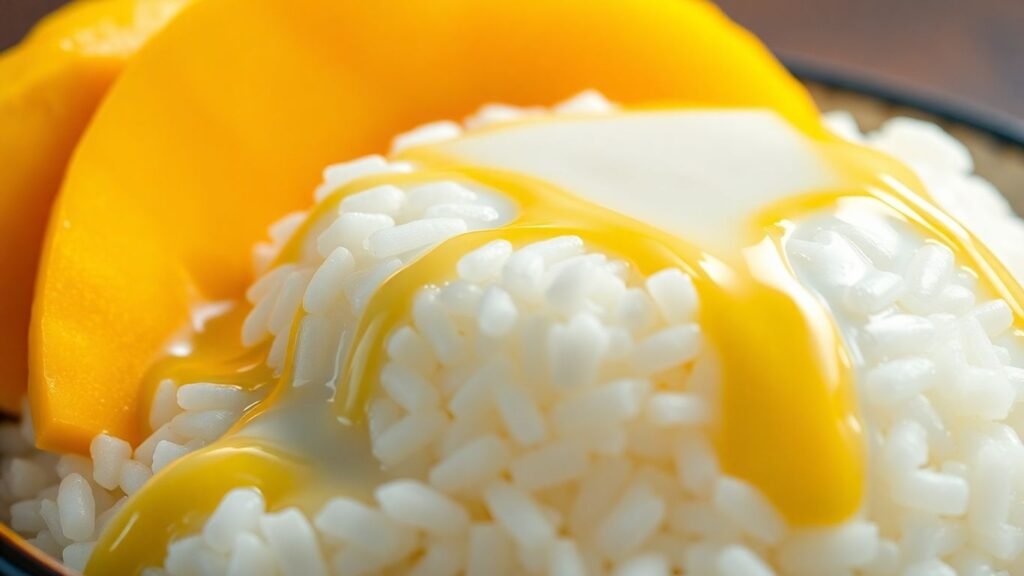Ever tried Thai mango sticky rice and thought, “There’s no way I can make that at home”? Well, think again! This classic Thai dessert, with its sweet, chewy rice and fresh, juicy mango, might seem fancy, but it’s actually pretty simple to whip up in your own kitchen. Forget those complicated restaurant versions; we’re going to break down how to make this treat without any fuss. It’s all about getting a few key things right, and before you know it, you’ll be enjoying this amazing dessert whenever the craving hits. So grab your sticky rice and let’s get started on some easy mango sticky rice recipes.
Key Takeaways
- Use the right kind of sticky rice, often called “sweet rice” or “glutinous rice,” which is different from sushi rice.
- Soaking and steaming are key to getting that perfect chewy texture for the sticky rice.
- Don’t skimp on the salt in the coconut sauce; it’s important for balancing the sweetness and bringing out the coconut flavor.
- Letting the hot, sweetened coconut milk soak into the steamed rice for about 30 minutes is crucial for flavor absorption.
- Serve the warm sticky rice with cool, fresh mango slices for a delightful temperature and texture contrast.
Understanding The Core Components Of Mango Sticky Rice

Mango sticky rice, or Khao Niao Mamuang in Thai, is a dessert that sounds simple but relies on the perfect harmony of just a few key players. It’s not just rice and fruit; it’s a carefully balanced treat where each part plays a big role. Let’s break down what makes this dessert so special.
What Is Mango Sticky Rice?
Mango sticky rice is a classic Thai dessert featuring sweet, chewy sticky rice that’s been infused with a rich coconut milk sauce, served alongside slices of fresh, ripe mango. It’s a popular street food and restaurant treat in Thailand, known for its comforting sweetness and satisfying texture. The magic happens when the warm, fragrant rice meets the cool, juicy mango, all brought together by that luscious coconut sauce.
The Role Of Sweet Sticky Rice
The star of the show, really, is the sticky rice, or khao niao. This isn’t your average long-grain rice. It’s a special type of rice, often labeled as
Mastering The Sticky Rice Preparation

Alright, let’s talk about the star of the show: the sticky rice. Getting this right is pretty important for that authentic Thai mango sticky rice experience. It’s not just any rice; it’s glutinous rice, also known as sweet rice. This is what gives the dessert its signature chewy, slightly dense texture.
Selecting The Right Type Of Sticky Rice
When you’re at the store, look for bags labeled “glutinous rice” or “sweet rice.” It usually comes in white, but you can also find black glutinous rice, which adds a nice color and a slightly different flavor. For a classic look and taste, white glutinous rice is the way to go. Don’t confuse it with regular long-grain rice or Arborio rice; they won’t give you that sticky texture. You can usually find it in the Asian foods aisle of your grocery store or at an Asian market.
The Soaking And Steaming Process
This is where the magic really happens. First, you’ve got to rinse the rice. Put your rice in a bowl and cover it with cold water. Swish it around with your hand, then drain the cloudy water. Do this a few times until the water runs pretty clear. This gets rid of excess starch that can make the rice mushy. After rinsing, it’s time to soak. Cover the rice with fresh water and let it sit for at least 4 hours, or even better, overnight. This rehydrates the grains and helps them cook evenly. After soaking, drain the rice really well. Then, you’ll steam it. You can use a traditional bamboo steamer, or rig up your own using a pot with boiling water and a sieve or colander. Make sure the rice isn’t sitting directly in the water. Steam it for about 20-25 minutes, flipping it halfway through. You want it to be translucent and tender, but still have a bit of chew.
Achieving The Ideal Chewy Texture
So, how do you get that perfect texture? It’s all about the soaking and not over-steaming. The soaking step is key for softening the grains. When you steam, keep an eye on it; overcooked rice will turn into a gummy mess. The goal is a texture that’s soft enough to eat easily but still has a satisfying chew. After steaming, the rice will absorb the coconut milk, which continues the cooking process and adds moisture. This is why it’s important not to overcook it initially. You want it to be just right so it can soak up all that delicious sauce without falling apart. A good way to check is to taste a grain – it should be tender but still have a slight bite to it. If you’re looking for a more detailed guide on the steps, this Thai mango sticky rice guide can be super helpful.
Crafting The Irresistible Coconut Sauce
Balancing Sweetness And Saltiness
The coconut sauce is where the magic really happens for mango sticky rice. It’s not just about sweetness; it’s about getting that perfect balance with a hint of salt. This contrast makes the whole dish pop. Too much sugar and it’s cloying, too little and it’s bland. You want just enough salt to make the coconut and sugar flavors sing. Think of it like adding a pinch of salt to chocolate chip cookies – it just makes everything taste better.
The Importance Of Full-Fat Coconut Milk
When you’re making this sauce, don’t skimp on the coconut milk. You absolutely need the full-fat kind. The lighter versions just don’t have the richness or the creamy texture that makes this dessert so decadent. Look for cans that say ‘full-fat’ or ‘premium’. The difference is noticeable; it gives the sauce body and a luxurious mouthfeel that you just can’t get otherwise.
Thickening The Sauce For Richness
To get that lovely, slightly thick sauce that coats the rice and mangoes just right, you’ll need a little something to thicken it. A common way to do this is with a cornstarch slurry. It’s super simple: just mix a bit of cornstarch with some water until it’s smooth, then stir it into your simmering coconut milk mixture. It thickens up quickly, giving you that perfect consistency without making it gloopy. You don’t want it too thin, or it’ll just run off, and you don’t want it too thick, or it’ll be like pudding.
Here’s a basic idea of what goes into the sauce:
| Ingredient | Quantity (approx.) |
|---|---|
| Full-Fat Coconut Milk | 1 cup |
| Sugar | 1/4 cup |
| Salt | 1/4 teaspoon |
| Cornstarch (for slurry) | 1 teaspoon |
| Water (for slurry) | 2 teaspoons |
Making the sauce ahead of time is a good idea. It gives the flavors a chance to meld together, and you can easily reheat it gently when you’re ready to serve. Just be sure to stir it well so it doesn’t scorch on the bottom.
Here are the steps to get your sauce just right:
- Combine the coconut milk, sugar, and salt in a saucepan over medium heat.
- Stir until the sugar dissolves and the mixture just begins to simmer. Don’t let it boil rapidly.
- In a small bowl, whisk together the cornstarch and water until smooth. This is your slurry.
- Slowly pour the cornstarch slurry into the simmering coconut milk while stirring constantly.
- Continue to stir until the sauce thickens to your desired consistency. This usually only takes a minute or two.
- Remove from heat and let it cool slightly before serving.
Assembling Your Delicious Mango Sticky Rice

Alright, so you’ve got your perfectly steamed sticky rice, your sweet and ripe mangoes, and that luscious coconut sauce. Now comes the fun part: putting it all together! It’s not complicated, but a few little things can make it look and taste even better.
Combining the Hot Coconut Milk and Rice
This is where the magic really happens. You want to take your freshly steamed, hot sticky rice and gently mix it with a portion of the warm coconut milk sauce. Don’t go crazy stirring it; you’re not making risotto here. Just a gentle toss to make sure every grain gets coated. Think of it as giving the rice a cozy bath in coconut goodness. The heat from the rice and the sauce helps them meld together beautifully. Some folks like to pour the sauce over the rice in a shallow dish and let it sit, covered, for about 20 minutes. This gives the rice a chance to really soak up all that creamy flavor. It’s a simple step, but it makes a big difference in how moist and flavorful the rice turns out.
Allowing the Flavors to Meld
After you’ve mixed the hot rice with the coconut sauce, it’s important to let it sit for a bit. This resting period, usually around 20 minutes, is when the rice truly absorbs the coconut milk. It’s like letting a good stew simmer – the flavors get a chance to deepen and get to know each other. If you skip this, your rice might be a bit dry or the coconut flavor won’t be as pronounced. So, cover it up and let it do its thing. This is also a good time to slice your mangoes if you haven’t already.
Serving Suggestions and Garnishes
Now for the grand finale! To serve, spoon a generous portion of the coconut-infused sticky rice onto a plate. Arrange your beautifully sliced ripe mango alongside it. Then, comes the drizzle. You’ll want to pour some of that extra, slightly thickened coconut sauce over the rice and mango. It adds another layer of richness and makes the whole dish look extra inviting. For that traditional touch and a delightful textural contrast, consider adding some crispy mung beans or toasted sesame seeds on top. They add a satisfying crunch that balances the soft rice and juicy mango. It’s these little extras that really make your homemade mango sticky rice feel restaurant-worthy.
Here are a few ideas for serving:
- Classic: Rice, mango, and a drizzle of coconut sauce.
- Crunchy Delight: Add crispy mung beans or toasted sesame seeds for texture.
- Extra Creamy: Serve with a small bowl of extra coconut sauce on the side for dipping.
The key is to serve the rice slightly warm, the mango cool, and the sauce at a temperature that complements both. This temperature contrast is part of what makes this dessert so special.
If you’re looking for a good coconut milk to use, check out this guide for recommendations.
Tips For Perfect Mango Sticky Rice Every Time
Making mango sticky rice at home can feel a little intimidating, but honestly, it’s pretty doable once you get the hang of it. A few little tricks can make a big difference, turning your dessert from ‘okay’ to ‘wow’.
Key Techniques For Success
- Don’t skip the soaking! This is super important for getting that signature chewy texture. Give your sticky rice at least 4 hours, or even better, overnight, to soak up water. This step really makes the rice tender and ready for steaming.
- Steam, don’t boil. Steaming is the way to go for authentic sticky rice. It cooks the grains evenly and keeps them from getting mushy. Make sure your steamer setup is good and tight so the steam doesn’t escape.
- Balance is everything. The coconut sauce is where the magic happens. You want it to be sweet, but also have a little salt to cut through the richness. A good ratio is key here. Too much sugar and it’s cloying; too much salt and it’s just weird.
- Use good quality coconut milk. This isn’t the place for light coconut milk or that stuff in a carton that’s mostly water. You need full-fat, creamy coconut milk, preferably from a can, for the best flavor and texture. It makes the sauce so much richer.
Avoiding Common Pitfalls
- Mushy rice: This usually happens if you overcook the rice or stir it too much after adding the coconut milk. Be gentle when you mix the hot rice with the sauce. Think of it as folding, not stirring.
- Dry rice: If your rice seems dry after resting, it might mean your coconut milk mixture wasn’t quite enough, or it evaporated too quickly. Make sure to cover it well while it rests.
- Bland sauce: The sauce needs a good balance of sweet and salty. If it tastes flat, you might need a tiny bit more salt or sugar. Remember, the rice will absorb some of this flavor, so the sauce should be a little more intense than you might think.
Expert Advice For Flavor Balance
The secret to truly amazing mango sticky rice often lies in the details. For an extra layer of aroma, try tying a few pandan leaves into a knot and simmering them in your coconut sauce. Just remember to remove them before serving. It adds a subtle, fragrant note that really makes the dessert special. It’s a small step that makes a noticeable difference.
Here’s a quick rundown of ingredient ratios that often work well:
| Component | Ratio (approximate) | Notes |
|---|---|---|
| Sticky Rice | 2 cups | Long-grain glutinous rice |
| Coconut Milk | 1.5 cups | Full-fat, for soaking rice |
| Sugar | 0.75 cup | Adjust to taste |
| Salt | 0.5 tsp | For soaking rice |
| Coconut Milk | 1 cup | Full-fat, for sauce |
| Sugar | 0.5 cup | For sauce |
| Salt | 0.5 tsp | For sauce |
| Cornstarch/Rice Flour | 1-2 tbsp | For thickening the sauce, if needed |
And don’t forget the mango! Using ripe, sweet mangoes is non-negotiable. Look for varieties like Ataulfo or Manila mangoes if you’re in North America. They’re usually sweet and not too fibrous, which is perfect for this dessert. You can find more tips on selecting the best fruit for your dishes on pages about fruit selection.
Storing And Reheating Your Mango Sticky Rice

Mango sticky rice is truly best when it’s fresh out of the kitchen. You know, that perfect moment when the rice is still a little warm and the mango is cool and sweet? Yeah, that’s the dream. But hey, life happens, and sometimes you have leftovers. Don’t toss them!
Best Practices For Leftovers
If you find yourself with extra mango sticky rice, the key is to keep things separate. Store the cooked sticky rice in an airtight container. The mango slices should also be stored separately, also in a covered container. The coconut sauce can be kept in its own container. Keeping the components separate helps maintain their individual textures and flavors until you’re ready to enjoy them again. It’s a simple step, but it makes a big difference.
Reheating Methods For Rice
Reheating sticky rice can be a little tricky, but it’s totally doable. The microwave is usually the quickest option. Just pop the rice in a microwave-safe dish, maybe cover it with a damp paper towel to help it stay moist, and heat it in short bursts. Give it a stir halfway through to make sure it heats evenly. You don’t want any cold spots! Another method is steaming. You can use a steamer basket over boiling water. Again, cover the rice, and steam until it’s heated through. Breaking up the rice a bit before reheating can help it warm up more evenly, no matter which method you choose.
Keeping The Coconut Sauce Fresh
Good news here! The coconut sauce is pretty forgiving. You can store it in a sealed container in the refrigerator for up to a week. When you’re ready to use it again, just give it a gentle reheat. A quick zap in the microwave or a few minutes on the stovetop over low heat should do the trick. You want it warm enough to pour easily, but not boiling hot. This way, you can still get that lovely drizzle over your reheated rice and mango.
Remember, while leftovers are great, the texture of the rice might change a bit after reheating. It might not be quite as chewy as when it was freshly made, but it will still be delicious. Don’t expect perfection, but do expect a tasty treat!
Enjoy Your Homemade Thai Treat!
So there you have it! Making authentic Thai Mango Sticky Rice at home is totally doable. It might seem a little tricky at first, especially getting that sticky rice just right, but trust me, it’s worth the effort. You’ve got the sweet, chewy rice, the fresh mango, and that creamy coconut sauce all coming together. It’s a dessert that really brings a taste of Thailand right to your kitchen. Don’t be afraid to give it a try – you might surprise yourself with how delicious it turns out. Happy cooking!
Frequently Asked Questions
What exactly is Mango Sticky Rice?
Mango Sticky Rice is a super popular dessert from Thailand. It’s made with sweet, chewy sticky rice that’s been cooked with coconut milk, and it’s served with fresh, sweet mango slices. A drizzle of creamy coconut sauce and sometimes a sprinkle of crunchy bits on top make it extra special. It’s a mix of sweet, a little salty, and totally delicious!

What kind of rice do I need for this recipe?
You absolutely need to use Thai sticky rice, also called “sweet rice” or “glutinous rice.” It’s a special kind of long-grain rice that gets nice and sticky when cooked because of its starch. Regular rice, like the kind you might use for regular meals, won’t work here. You can usually find Thai sticky rice at Asian grocery stores or online.
What’s the best type of mango to use?
For the best flavor, look for sweet and smooth mangoes that aren’t stringy. In Thailand, they often use specific types like ‘Ataulfo’ or ‘Manila’ mangoes, which are sometimes called ‘Champagne’ mangoes. The most important thing is that the mango is ripe, sweet, and juicy. If you can’t find those, any ripe and sweet mango will do!
Why is there salt in the coconut sauce?
That little bit of salt in the coconut sauce is super important! It doesn’t make the dessert taste salty, but it actually balances out the sweetness from the sugar and mango. It also helps bring out the rich coconut flavor, making the whole dish taste even better. Trust me, it’s a key part of what makes this dessert so amazing!
Can I make Mango Sticky Rice ahead of time?
It’s best to enjoy Mango Sticky Rice right after it’s made when the rice is warm and the mango is fresh. However, you can cook the sticky rice and make the coconut sauce a day ahead. Store them separately in the fridge. When you’re ready to serve, gently warm the rice and sauce, then add the fresh mango.
How do I reheat leftover sticky rice?
If you have leftovers, you can reheat the sticky rice by covering it with a damp paper towel and microwaving it until it’s hot. You can also steam it in a steamer basket. It’s a good idea to break up the rice a bit halfway through heating to make sure it warms up evenly. The coconut sauce can be gently reheated on the stove or in the microwave.


